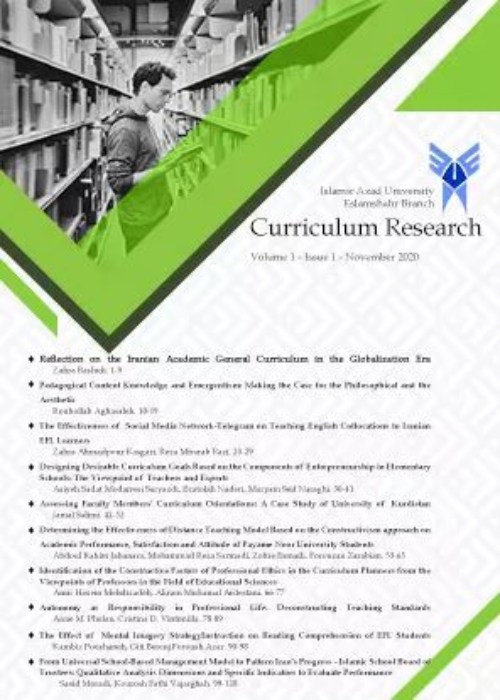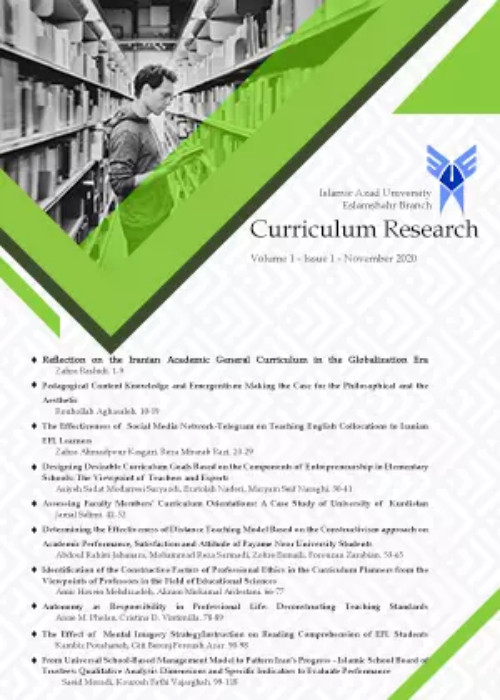فهرست مطالب

Curriculum Research
Volume:3 Issue: 3, Jul 2022
- تاریخ انتشار: 1401/12/27
- تعداد عناوین: 6
-
A Comparative Study of Male vs. Female Iranian EFL Learners’ Willingness to Communicate and International PosturePages 1-12
AbstractThe concept of willingness to communicate (WTC) in a foreign or second language (L2) has been widely used after the rising popularity of communicative language teaching (CLT) movement. Recent research has concentrated on various factors that may influence L2 learners’ WTC. International posture (IP) is another related concept that refers to L2 learners’ attitudes towards the people and the community whose language they are trying to learn. The current research attempted to compare the amount of WTC and IP across Iranian male and female EFL learners and also to investigate the relationship between the two variables in two genders. The study was conducted with a group of 112 (49 male and 63 female) participants selected from an initial group of 171 EFL learners who studied English language teaching and translation in four universities in East Azarbaijan Province, Iran. The data were collected by the administration of a questionnaire known as ‘WTC Scale’ published by McCroskey (1992) and the IP questionnaire made by Yashima (2002). Between-group comparison was made to compare the male and female groups. The results of the analyses showed that there was no significant difference between the two groups in terms of both WTC and IP. The Pearson Correlation analysis on the questionnaire data also showed that there was almost high positive correlation between WTC and IP in both male and female groups. The findings of the study could offer pedagogical implications for EFL teachers, learners and material designers as well as suggestions for further research.
Keywords: Learner Gender, International Posture, Willingness to communicate -
Designing and Validating the Model of Extracurricular Curriculum for Compatible with student brain Low attention / Hyperactive primary schoolPage 2Purpose
The aim of this study was to design and validate an extracurricular curriculum model Compatible with students' brains in low-attention/Hyperactive primary schools.
MethodologyThe research was applied in terms of purpose and heuristics using a mixed method. 17 people were selected by purposive sampling according to the principle of theoretical saturation. In the quantitative community, educational experts, counsellors, and primary teachers of Mashhad in 2020–21, 419 people were selected by multi-stage cluster sampling. The tools of the qualitative part of the interview were semi-structured, and their validity was obtained with content validity and their reliability with the coding agreement coefficient. The quantitative part of the questionnaire was a researcher-made questionnaire with 187 items; the content validity of the questionnaire with the opinion of experts and reliability with Cronbach's alpha were 83%. Qualitative data were analyzed by content analysis and coding, and quantitative descriptive statistics were performed by SPSS 23 and AMOS 26 software.
FindingsThe findings of this study, Characteristics of Components, Purpose, Content, Teaching-Learning Strategies and Evaluation, Learning Space, Resources, Teacher Role, Learning Time, Grouping, and Inclusive Characteristics, play a role in providing the model, and their brain characteristics and special needs are the priority of the complementary curriculum. Emphasis is placed on goals, more interactive teaching methods, eliminating time constraints, reducing the volume of lessons, and presenting them in various formats.
ConclusionAccording to the research findings, the designed model and its use help to improve the performance of this group of students.
Keywords: Supplementary curriculum, Compatible with the brain, careless, Hyperactive -
The Impact of Dynamic Written Corrective Feedback on EFL Writing Accuracy, Fluency, and ComplexityPage 3Purpose
The current study intended to assess the impact of dynamic written corrective feedback (WCF) on helping Iranian EFL learners to write better narrative essays in English with respect to conditional sentences as the newly learned grammatical instruction.
MethodThis study was mixed in terms of the nature of the data and was organized into two parts: quantitative and qualitative. In the quantitative method, the participants were fifty-four EFL learners from the intermediate level. They were allocated to an experimental group that received dynamic (WCF), and a control group that was taught based on the traditional writing approach. The subjects were tested before and after the treatment. In order to answer the first research question, independent t-tests were run. In the qualitative method, data from eight face-to-face interviews with EFL teachers have been analyzed and compared in an effort to discover the type of corrective feedback EFL teachers believe helps learners in developing various writing skills.
FindingsConcerning the research's first question, independent t-tests proved that dynamic (WCF) affected students` performance on writing accuracy, fluency, and complexity with regard to conditionals. In addition, data from interviews with EFL teachers supported the incorporation of a combination of direct and indirect written corrective feedback methods recently known as dynamic WCF when assessing foreign language writers.
ConclusionAccording to the findings, the application of dynamic WCF had a noticeable impact, and empowered the EFL learners to utilize the conditional sentences with more accuracy, fluency, and complexity.
-
Evaluation of the effectiveness of virtual mathematics teaching based on manipulative mathematical learning in 6th-grade elementary male students in 5th districts of Tehran in Covid-19 pandemicPage 4Purpose
One of the problems of elementary school teachers is mathematics teaching that it has become a serious challenge in the Covid-19 pandemic, which has led to the quarantine of students and subsequent virtual education. The main purpose of mathematics teaching is to shape the conceptual understanding of mathematics.
MethodologyThis study is a quasi-experimental research with pre-test and post-test experimental and control groups, in order to investigate the changes before and after applying the intervention in the experimental group and compare it with the control group. The population of this study included all 6th-grade elementary male students in the 5th district of Tehran in the academic year 2021-22. The sampling method was available sampling and the sample included 72 sixth-grade elementary male students of primary school who were randomly divided into experimental and control groups (36 students in each group).
FindingsThe results showed that as compared to the students in the control group who did not receive this program, teaching the experimental group that received this program by using the virtual mathematics teaching based on manipulation had a significant impact leading to an increase in the mathematical learning of the students.
ConclusionAccording to the obtained results, in this educational approach, discovering solutions to problems and solving exercises by the students themselves effectively helps to improve their learning, thus it can be suggested that the teaching based on manipulation can be used to teach virtual mathematics in primary schools.
Keywords: Virtual Teaching, Manipulative, mathematical learning, Covid-19 pandemic -
Provide a knowledge management model for primary school principals (Case study of Tehran)Page 5Purpose
The purpose of this study is to design a knowledge management model for primary school principals in Tehran.
MethodologyThe research method is applied in terms of purpose and qualitative in terms of data type and emerging data in terms of nature and type of data study.
FindingsThe competitive environment of organizations is becoming more complex and rapidly changing. In such a way that the speed of change in most organizations is much faster than the speed of their ability to respond and adapt. Constant changes in internal conditions and external environments have also created a new state of imbalance for organizations. In the meantime, only organizations can survive that can maintain their competitive advantage. This issue has created many concerns for organizations, the most important of which can be to identify shortcomings (gaps), more productivity of human capital, and more efficient learning. And more effective employees, providing more value-added goods and services, customer and employee satisfaction, preventing the repetition of mistakes, reducing rework, saving time, motivating creativity and innovation, and strengthening the competitive position of organizations.
ConclusionApplying knowledge management in this field can be an important factor to respond to these concerns. In other words, in the meantime, only organizations can survive that maintain their competitive advantage. According to thinkers in this field, maintaining advantage Competitiveness and survival of the organization is possible with the help of knowledge management. In order to be able to continuously create new knowledge in the organization.
Keywords: Knowledge management, organization analysis, Human Capital -
Comparing the Shahid Motahari and John Locke's Philosophical Foundations of Citizenship Education and Providing Solutions for Iran's EducationPage 6Purpose
Considering the importance of philosophical foundations in citizenship education, the aim of the present study was comparing the Shahid Motahari and John Locke's philosophical foundations of citizenship education and providing solutions for Iran's education.
MethodologyThis study in terms of purpose was applied and in terms of implementation method was qualitative from type of descriptive-analytical. The research population were included all the first-hand sources related to the Shahid Motahari and John Locke's philosophical foundations of citizenship education and the second-hand sources related to it, including articles, theses, and books. For sampling was used from census sampling method. The data were collected by note-taking method from first-hand and second-hand sources and analyzed with theoretical and critical inference methods.
FindingsThe findings showed that based on the Shahid Motahari's philosophical foundations of citizenship education, in the ontological dimension, man considers existence to have a purpose and harmony, in the epistemological dimension, man establishes a relationship with the world in the direction of eternal salvation and man is aware of sensory, intellectual and heart cognitions to know oneself and the society, and in the values dimension, man gives value and importance to his goals. Also, based on the John Locke's philosophical foundations of citizenship education, in the ontological dimension, human beings are equal and everyone has the right to enjoy life, health and freedom, in the epistemological dimension, man communicates with the world by observing the consequences of his behavior or the cause and effect relationship,
Keywords: philosophical foundations, Citizenship education, epistemological, education


